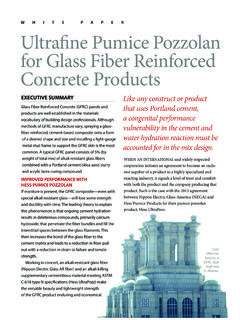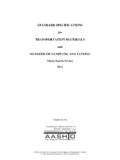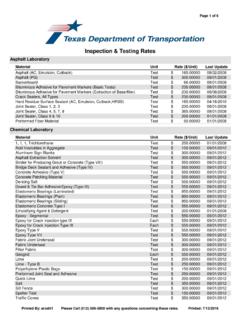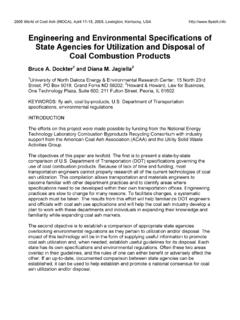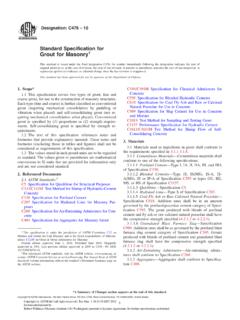Transcription of STRUCTURAL PROPERTIES OF RICE HUSK ASH CONCRETE.
1 May 2013. Vol. 3, No. 3 ISSN2305-8269. International Journal of Engineering and Applied Sciences 2012 EAAS & ARF. All rights reserved STRUCTURAL PROPERTIES OF rice HUSK ASH CONCRETE. Godwin A. Akeke, Maurice E. Ephraim, Akobo, and Joseph O. Ukpata. Department of Civil Engineering, Cross River University of Technology, Calabar, Nigeria. Abstract This research was experimentally carried out to investigate the effects of introducing rice Husk Ash (RHA) as a Partial Replacement of Ordinary Portland Cement (OPC) on the STRUCTURAL PROPERTIES of Concrete. rice Husk Ash which is an Agro-Waste and known to be a Super Pozzoland have been used for mass concrete and found to have compressive strength ranging from replacement percentages of 10-25% in a mix of 1 :3. A further study was carried out on its flexural PROPERTIES to determine their moduli of rupture as well as its tensile strength characteristics for the determination of cracking, the values obtained at 28days are 3, and while the tensile strength values are , and at replacement percentages of 10%, 20% and 25%.
2 This research has proved that RHA Concrete can be used as a STRUCTURAL Concrete at suitable replacement percentages. This research therefore is an investigation of the performance of the concrete made of partially replacing OPC with RHA on the STRUCTURAL integrity and PROPERTIES of RHA concrete. Keywords: rice Husk Ash, STRUCTURAL PROPERTIES and Concrete. INTRODUCTION. which itself possess little or no cementing property, This research is aimed at putting into effective use but will in a finely divided form and in the rice Hush Ash (RHA) a local additive which has presence of moisture chemically react with calcium been investigated to be super pozzolanic in a good hydroxide at ordinary temperatures to form proportion to reduce the high cost of STRUCTURAL compounds possessing cementite's PROPERTIES . A. concrete. rice Husk Ash (RHA) is an agricultural good way of utilizing this material is to use it for waste product, and how to dispose of it is a making high performance concrete which means problem to waste mangers.
3 While Concrete today high workability and very high early strengths, or has assumed the position of the most widely used consider high workability and long term durability building material globally. The most expensive of the concrete. concrete material is the binder (cement) and if such all-important expensive material is partially Materials replaced with more natural, local and affordable rice Husk Ash (RHA); rice Husk was material like RHA will not only take care of waste burnt for approximately 48hrs in an open management but will also reduce the problem of air and uncontrolled burning process. The high cost of concrete and housing. temperature was in the range of 400- 6000C. The ash collected was sieved There is an increasing importance to preserve the through BS standard sieve size 75 m and environment in the present day world. RHA from its colour was grey. Batching was done by the parboiling plants is posing serious volume at replacement percentages of 10, environmental threat and ways are being thought of 20, and 25%.
4 To dispose them. This material is actually a super Cement pozzolan since it is rich in Silica and has about Ordinary Portland cement (OPC) was used 85% to 90% Silica content. in which the composition and PROPERTIES is A pozzolan is therefore defined as a siliceous or in compliance with the Nigerian siliceous and aluminum material, standard organization defined standard of cement for concrete production. 57. May 2013. Vol. 3, No. 3 ISSN2305-8269. International Journal of Engineering and Applied Sciences 2012 EAAS & ARF. All rights reserved Aggregates The following tests were carried out in The project work is restricted to sand accordance with relevant BS Standards. collected from the river. The sand was 1. The aggregates were tested for physical collected to ensure that there was no PROPERTIES such as: specific gravity, allowance for deleterious materials Particle distribution test and bulk density. contained in the sand. 2. The fresh concrete was subjected to the In this research, granite of 20mm following tests.
5 Maximum size was used. Proper (i) Slump inspection was carried out to ensure that it While the following PROPERTIES were tested was free from deleterious materials. in the hardened state of the concrete. Granite was gotten from zenith quarry in (i) Density test Akamkpa Cross River state. (iii) Compressive strength test. Water (iv) Flexural strength test Water plays an important role in concrete (v) Split tensile test. production (mix) in that it starts the reaction between the cement and the RESULTS AND DISCUSSION. aggregates. It helps in the hydration of the Physical PROPERTIES of rice Husk Ash (RHA);. mix. In this project, the water used was Sand and Gravel Pipe borne water and free from The following physical PROPERTIES of contaminants. RHA, sand and aggregate were Method of Experiment investigated in the laboratory and the Concrete is a mixture of water, cement, results obtained from the specific gravity aggregate (coarse and fine) and admixture. test as shown below It is important that the constituent material Results of Specific Gravity remain uniformly distributed within the These results show that the specific concrete mass during the various stages of gravity of RHA varies from to handling and that full compaction is with an average value of , while the achieved, and making sure that the specific gravity of sand used had a characteristics of concrete which affect constant value of full compaction like consistency, mobility Particle Size Distribution : The results of the and compatibility are in conformity with particle size distribution analysis carried out in this relevant codes of practice.
6 Research work are as shown bellow Table 1a-Sieve Analysis of RHA (TM = 1500). Sieve Size Weight % Retained % Passing Retained 0 100. 0 100. 600 34 425 41 85. 300 150 30 55. 212 57 150 81 63 100 Pan 35 0. 58. May 2013. Vol. 3, No. 3 ISSN2305-8269. International Journal of Engineering and Applied Sciences 2012 EAAS & ARF. All rights reserved Table 1b-Sieve Analysis of Sand (TM =500). Sieve Size Weight % Retained % Passing Retained 0 100. 0 100. 5 130 600 429 425 345 300 338 212 126 150 80 63 43 Pan 4 0. Table 1c-Sieve Analysis of Gravel 5-20 (TM=1485). Sieve Size Weight % Retained % Passing Retained 20 0 100. 13 4 10 18 119 8 70 234 Pan 40 Table 1d-Sieve Analysis of Gravel 15-25 (TM=1660). Sieve Size Weight % Retained % Passing Retained 37 0 100. 25 236 20 993 13 435 0. 10 0 0 0. pan 0 0 0. 59. May 2013. Vol. 3, No. 3 ISSN2305-8269. International Journal of Engineering and Applied Sciences 2012 EAAS & ARF. All rights reserved Bulk Density the European classification ENV 206:1992 having the slump of 50-90 and by TRRL classification, the The bulk densities of RHA, sand and the coarse workability is described as medium with aggregate used was found to be 20, 45 and 65kg/m3 compacting factor of and slump of 50.
7 Respectively. 100mm. Workability (Slump) Density The workability test results are presented in The density of RHA was investigated and results Appendix IV. The workability test results show which are analyzed and presented as a ratio of the that RHA concrete can be graded under S2 using mass to that of the volume are given below. Table 1e. Density Values for Various RHA Concrete Mixes. Age Percentage Replacement with RHA. 10% 20% 25%. Average Densities 7 2038 1901 1948. of RHA Concrete in 14 2052 1875 1914. KN/m3 21 2064 1909 1937. 28 2017 1950 1902. From the above results of density it can be seen that the density of RHA is in the same range for all replacement levels. According to BS 877, it can be classified as light weight concrete. Table results of the compressive strength of RHA Concrete. Age Percentage Replacement with RHA. 10% 20% 25%. Average Compressive 7 12 11 10. strength N/mm2 14 14 13 12. 21 18 18 14. 28 22 20 19. Split Tension Test Results The results of our investigations on the 28days RHA concrete are presented in Table 1g.
8 Below. From the results it can be seen that the tensile strength results are similar at all replacement percentages which is in line with the projections of the other researchers. Table 1g below is the presentation of the results of the split tension test. SN % Replacement Breaking Load N/mm2 Tensile Strength N/mm2. 1 10% 304738 2 20% 91500 3 25% 79500 60. May 2013. Vol. 3, No. 3 ISSN2305-8269. International Journal of Engineering and Applied Sciences 2012 EAAS & ARF. All rights reserved Flexural strength investigation The flexural strength PROPERTIES of RHA concrete was investigated in the laboratory, the results of this investigation are presented in table 1h below The flexural strength fb (in N/mm2) is given by = . Where, = the breaking load (in N). d1 and d2 are the lateral dimensions of the cross-section (in mm). L = the distance between the supporting rollers (in mm). Table 1h- Flexural Strength Values of RHA Concrete at 1:11/2:3 mix SN % Replacement Breaking Load N/mm2 Flexural Strength N/mm2.
9 1 10% 7000 2 20% 6000 3 25% 4800 CONCLUSION. From the experiments and analysis of good for STRUCTURAL concrete at 10% replacement results of findings in this research work, level. the following facts are established about RHA Concrete. References RHA is a super pozzolan and its use in 1. Ephraim etal, (2012): Compressive Strength of Concrete with RHA as Civil Construction, besides reducing environmental partial replacement of ordinary polluters factors, will bring several improvements Portland Cement. Scholarly Journal to concrete Characteristics. The compressive of Engineering Research Vol. 1(2)pp32-36. strength and workability tests suggests that RHA. could be substituted for OPC at up to 25% in the 2. Ogunbode etal (2012): An evaluation production of concrete with no loss in workability of compressive Strength of Concrete or strength. Based on the results of split Tensile made with RHA obtained by open air burning. www. Strength test, it is convenient to state that there is no Substantial increase in Tensile Strength due to 3.
10 Muga,H etal (2005): Development of the addition of RHA. The Flexural strength studies appropriate and Sustainable Construction Materials. www. indicate that there is a marginal improvement with 10 to 25% RHA replacement levels. rice Husk Ash concrete possess a number of good qualities that 4. Karim, MR (2012): Strength of make a durable and good STRUCTURAL concrete for Mortar and Concrete as influence by RHA. both short term and long term considerations. It is (10)12/19. 61. May 2013. Vol. 3, No. 3 ISSN2305-8269. International Journal of Engineering and Applied Sciences 2012 EAAS & ARF. All rights reserved 5. Cook, D. J. (1996): rice Husk Ash 14. ASTM C1202: Electrical indication increment Replacement Materials, of concrete's Ability to Resist Concrete Technology and Design, Chloride ion penetration, Annual Vol. 3 Ed. R. N Swamy, Surrey Book of American Society for testing University Press, Uk. Materials Standards, Vol. C04, 02, 1993. 6. Coard, J. R (1993): Natural Pozzolans, Published by the 15.





